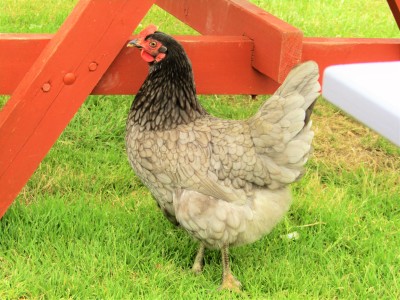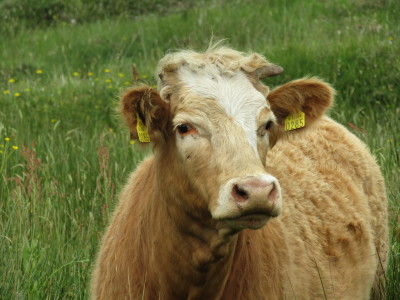Tag Archives: travel
Bloomsday
Good Friday: Notre Dame
It’s a quiet, rainy Good Friday. Currently contemplating whether I should go out and try to get some pictures of the procession. Wanted to comment a bit on Notre Dame and the fire. First, read this great piece by historian Tom Holland. Second, I’m a bit tired of hearing all of this silly sort of “instead of millionaires donating money to rebuild a church, shouldn’t these same millionaires be building houses for the poor” comment repeated over and over. Lovely ideal, but one needn’t have spent years studying economics to understand why this is not how things function. If it were that simple such decisions would be so much easier and clearer, and no one would be destitute.
Third, here’s a bad photo I took of Notre Dame, four years ago. I have taken good photos of the cathedral, but I have a fondness for this picture above the others. Significant Other and I were in Paris and I convinced him to take a boat ride along the Seine. I had seen Audrey Hepburn and Cary Grant do the same in Charade and imagined us in elegant splendour, drinking champagne. Instead, ’twas a nightmare: crowded with loud, aggressive tourists; cold; rushed. I am a seasoned traveler, and should have known this was how it would be, but…I did get this photo and we had a great laugh about the whole experience.

Molly Gallivan’s
For St. Patrick’s Day, another memory from last year’s trip to Ireland: a visit to Molly Gallivan’s, a cottage, shop, farm and restaurant in County Kerry. It overlooks the Sheen Valley – what absolutely stunning views. But what was so charming was the history of the place (click the link above), and the “poitin” we drank. Poitin is a kind of local potato whiskey – moonshine, I guess. The Irish call it “mountain dew” (not the pop), and Molly Gallivan’s owner, Stephen O’Sullivan (photo below) gave us a talk about its history, before pouring us each a glass. It hit the spot, that’s for sure.
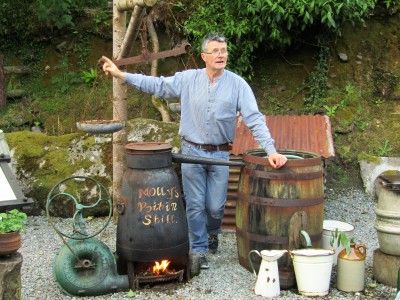
St. Patrick’s Day
For St. Patrick’s Day, here is a photo from my trip to Ireland last year: it’s Maureen O’Hara’s house on Bantry Bay! (She doesn’t live there now, obviously, as she is dead.) FYI, The Quiet Man is on TCM tonight – you are a fool if you don’t watch it (or at least tape it to watch it later). And if you don’t get TCM and/or haven’t seen The Quiet Man, purchase/rent the film, pronto.

I Shall But Love Thee Better After Death
And when thou hast learned to spell my name correctly! This is a photograph I took in Florence, Italy, recently, and it is an “Elizabeth Barrett Browning lived here” plaque, with some poetic writing about her-heart-of-a-woman, et cetera. That said, it spells her second name incorrectly – without a double T. Doppia T, Italians!
What I love about it, as a student of the Italian language, is the use of the passato remoto and the imperfect. I took a translation course in Italy in February and it was really hard to get the hang of when to use those two together.

Gentle Faces
The Cats of Whiddy Island
[Editor’s note: this story refers to the trip I wrote about at length here and also describes the events during which this photo was taken.- RA.]
The cats came running as soon as the ferry arrived at the pier. We followed our guide toward the Bank House, tiny Whiddy Island’s main – make that only – pub and hub, and two wild, furry little characters begged for pets and scritches. I was over the moon. I had been in Ireland a few days and hadn’t seen a cat yet. Sheep, cows, seals, eagles, chickens, horses, donkeys and dogs, yes. And yes, those beasties made this animal-lover happy, but cats are special. Because my name is Rondi and I am a cat lady.
When I lived in Istanbul I would have to factor in at least an extra half hour for my morning trek to work, to accommodate all the time spent stopping to cuddle local cats. At a kibbutz in Israel I took fish from the breakfast buffet and fed it to the feral colony outside. When I visit Paris, I make my way to Montmartre Cemetery to see the feral colony that sleep on Truffaut and Stendhal’s tombs. When I visit Rome, I hightail it to the Protestant Cemetery and commune with the cats who contemplate life at Keats’ grave and who nap on top of Gramsci’s eternal resting place.
Rome, of course, has plenty of feline activity, including the famous shelter which borders the Roman ruins near Torre Argentina. The great and glamorous Anna Magnani used to feed the cats in the area when she was performing at the Teatro Argentina, long before the creation of the current shelter.
One would assume that Magnani’s status as a ‘gattara’ – the Italian term for cat lady – would put to rest the lie that all cat ladies are dowdy old maids, but it is a stereotype that persists. A 1950s rom-com set in Rome features a scene that gives the stereotype cinematic life: in 1954’s Three Coins in the Fountain, Dorothy McGuire – in love with a seemingly oblivious Clifton Webb – is given a kitten by her maid, Louisa. “I am worried about you being alone, Signorina,” says Louisa, explaining that her sister is a spinster who talks to her many cats “from morning to night.”
Mamma mia!
Dorothy McGuire decides this will not be her fate. “It hasn’t come to that yet,” she says to the kitten. “You’re dear and small, but I’m not going to turn to you out of loneliness.”
I’ve never turned to a cat out of loneliness. I just find they are frequently better company than humans, and like Ernest Hemingway, I believe that one cat always leads to another. I’m not a spinster and I am (mostly) not dowdy, though I suspect I looked mighty dowdy during my recent trip to Ireland. I packed light as I can’t bear checking bags – too much lost luggage in my past – which meant my fellow travelers saw me in the same clothes more than they might have liked. It also meant that I neglected to bring my flat-iron. In other words, crazy-haired woman steps off the pier onto the soil of Whiddy Island and runs with delight into the paws of a couple of scruffy Irish cats.
And there began a tale. Travel they say, opens your mind to different peoples and cultures. It can and sometimes does, though I’ve often found it merely confirms what you already know. If it’s effective, it opens your mind to a bit of how you can be when you’re not at your best, to some of your less attractive traits. This is what happened to me on Whiddy Island.
Whiddy is a wee spot (5.6 kilometres long and 2.4 kilometres wide) off the coast of County Cork, Ireland. Ferries leave Bantry pier for Whiddy several times a day in summer months and less frequently the rest of the year. The island has a permanent human population of 22, many of whom speak Irish and an animal population of more than 22, each of whom may or may not speak Irish.
Two of the latter were those cats who came running. One was orange and white, the other a calico/tortoiseshell mix, so I knew she was a female. They were both old and thin, both highly affectionate and trusting, both desperate for every bit of contact the ferry full of tourists could give them. And both had dirty coats and ears that looked either frost-bitten or as if they had been torn during a street scrap. I wondered how much care they were getting. I don’t expect ferals, strays or even old cats to look as plump and happy as younger, indoor cats, but I was alarmed by their gritty coats and bony frames.
The more time I spent with the female – “the little old lady” was how I began to think of her — the more upset I got. She was having trouble walking, and her breathing sounded raspy. I know that rural life is different than urban life – for humans and non-human animals alike — but I was worried. I hoped my tone was caring, but in retrospect I think it far more likely to have been accusatory. Why, I asked our tour guide, aren’t they being fed? These cats are helping control the mouse and rat population; people should be grateful.
(Little Old Lady)
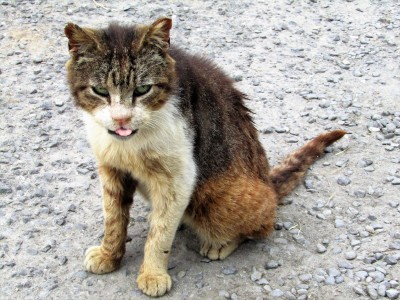
(Orange and White Lad)
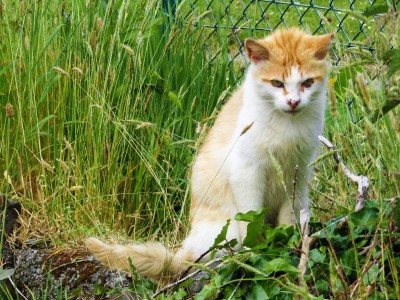
What I didn’t mention was that I have worked for years for a cat rescue in Toronto and have seen cats in worse shape, as I had seen cats in worse shape in Istanbul. But the difference in both cases was that in Toronto and Istanbul, I could do something. I felt powerless in Ireland, and frustration compounded my concern.
As we continued our tour of the island, I kept wondering whether I could commandeer a boat and take the cats to the mainland for a veterinary visit. I couldn’t, and as we left, I saw the little old lady and her orange and white friend sitting in the tall grass, sunning themselves. I had to admit they looked contented. Still, our wonderful guide promised to do what she could to investigate, and if needed, help.
Back in Canada, I downloaded my photographs. Calmly looking at images allowed me to see what I had missed in the frenzy of activity on the island: both cats had tipped left ears, rather than what I had initially thought (though the calico had a ragged right ear, as well). Ear-tips are an international sign of TNR, or trap/neuter/return, indicating that feral and stray cats have been spayed or neutered. Relief flooded in, along with some embarrassment. I don’t think it was wrong of me to have been upset, or to have intervened. Too many ignore animal suffering. But I had ascribed negligence, or worse, where there was none. I had made assumptions without finding answers. Casting blame first is not helpful. Where there is doubt let me sow faith; where there is darkness, let me sow light, as the prayer of St. Francis – patron saint of the animals — says.
I found, through the wonders of the internets, the rescue group responsible for the area. I discovered that the Whiddy cats were fed by locals and given as much care as possible, considering the geographic limitations of island life. I struck up an online conversation with one of the rescue’s volunteers and learned that the little old lady was simply that – a very old lady no longer in the bloom of her youth.
A few days later a message from my tour guide – who had indeed reached out for help and information about the cats of Whiddy — brought sad news: my calico friend had died peacefully shortly after our visit. I’m grateful to have met her and to have learned from her. May she rest in peace and may she cuddle up for eternity on the lap of Anna Magnani.
(Little Old Lady Enjoying the Sun)
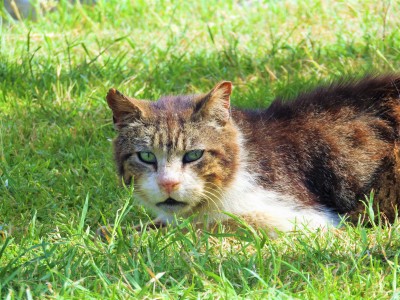
(Orange and White Lad in the Tall Grass)
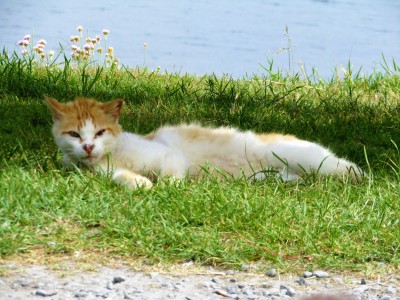
Whale Watching in Ireland
Had a wonderful whale-watching experience earlier this summer off the coast of Ireland. I referred to it in my travelogue for Go World Travel. What follows are a few photos – I saw Basking sharks, Minke whales and Risso dolphins. I only got photos of the first two, and not great ones at that, but the experience was extraordinary. We also saw – most unfortunately – how much plastic there is floating around out there.
First two photos are the Basking shark, or rather, his fins. Cannot impress upon you all how goose-bumpy it was to see him swimming about with his mouth wide open, something I didn’t capture in the photos.
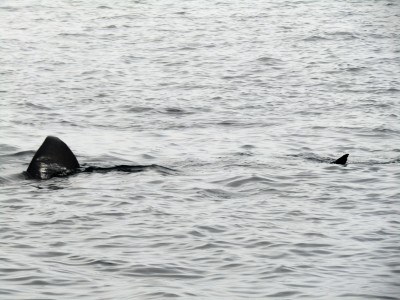
Same fins, different angle.
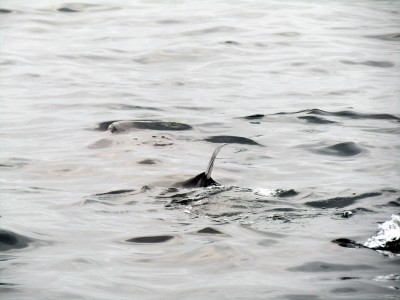
From a distance, a Minke whale, frolicking.
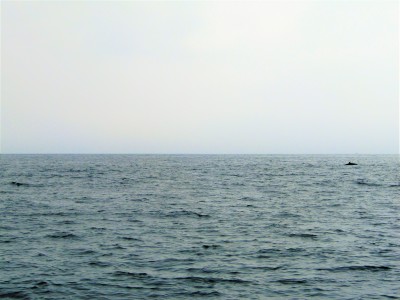
Handsome Captain Nic Slocum, with a stupid balloon pulled out of the water near our boat – seriously people, rose petals are just as good for a birthday celebration, and won’t hurt any living creatures.
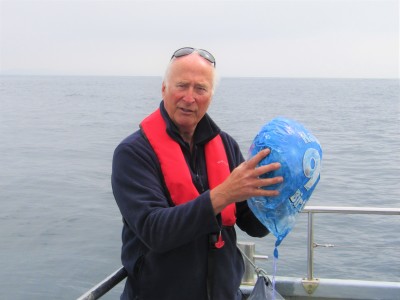
Please check out Whale Watch West Cork (link above) for tours around the world, including here in Canada.
Travelling While Canadian
In the autumn of 2016 I was studying at a university in central Italy. The morning after the American election, my grammar professor walked into class muttering “incubo, e un incubo!” A nightmare! It’s a nightmare. We all knew to what he was referring. Italian universities lean the same way politically as those in Toronto, New York or Middlebury, Vermont.
He kept shaking his head in horror, and asked my one American classmate, a woman from Texas, “Come ti senti?” How do you feel? I felt sorry for her, put on the spot like that, but she handled it with aplomb, admitting surprise at the result and nothing more. If our professor was hoping for an argument or confirmation of his own views, she wasn’t going to help him.
How great to travel while Canadian, I have often said, because no one knows or cares whom you elect as leader, just as no one seems to know much about your country. I was working in Japan during a Canadian federal election years ago, and not one of my highly-educated colleagues knew or cared Canada was having an election, much less who won.
What people do “know” about Canada is often inaccurate: it’s always cold everywhere (no); Canadians all have moose in their backyards (if only!); Canadians are nice (“harmless” might be a better word); English and French Canadians hate each other (those days are gone – now it’s all about indifference); Canadians are boring (“sanctimonious” might be a better word).
But things are changing, and not for the better, as I discovered on a recent trip to Ireland.
Ireland is a glorious place – my trip was in the middle of this year’s hot, bright green summer — and I travelled primarily in the counties of Cork and Kerry along the southern Atlantic coast. It was as wild and elegant and stunning as I imagined, and as friendly. People speak English in Ireland, but occasionally they use expressions one cannot decipher, even if one has read or sung “Finnegans Wake.” (I have attempted the former and accomplished the latter.) Couple that with the chattiness of nearly everyone I approached, and the simple act of asking “do you have decaf Irish coffee” or “what breed of sheep are those” could lead to confusion, which could lead to extended conversations, which often led to my being asked my nationality.
And whenever the great Canadian reveal happened, I would be met with a variation on the following: “Justin Trudeau is so cute! He’s a feminist! He’s so clever!” The power of social media added to an energetic, left-of-centre politician with Tiger Beat looks – the son of the other globally famous Canadian politician –has brought the bliss of being a Canadian abroad to a halt.
My standard reply was, “Yes, he is cute.” Sometimes I would go out on a limb with, “Yes, he’s super cute!” I couldn’t bear to risk the crestfallen look on people’s faces if I admitted that I think his main strength is virtue-signalling or that while I feel lucky to be Canadian, I don’t share what appears to be the glowing international consensus on Canada’s leader.
And it is international – during my trip I met people from all over the world who made similar comments. A French woman got the truth out of me, though – or perhaps it was my heavy sighing, eye-rolling and nose-crinkling when Trudeau’s name was uttered that gave it away — and told me how tired she was of hearing similar praise of Emmanuel Macron. She singled out his posturing as the “gender equality” president as something that drove her particularly mad.
I too recoil at men who make a public display of caring about “women’s issues” – it reeks of condescension and protesting too much. I was in Ireland shortly after the referendum which liberalized that country’s abortion laws, and about which there was still much talk. Trudeau, woke fellow that he is, tweeted enthusiastic praise for the results – “what a moment for democracy and women’s rights!” I am pro-choice, but I found the cheering unseemly.
Fortunately, I did get some respite during my trip. It happened at a beautiful spot in Kerry – a redundancy if ever there were one – when I began chatting with a man from Kansas about our respective itineraries. We were joined by some friendly German tourists far more interested in expressing their mystification at Donald Trump than in discussing the wonders of Canada’s prime minister, or of Ireland. As in Italy, I felt bad for my midwestern acquaintance – who remained affable under bombardment – and it occurred to me that I could derail the conversation by, say, mentioning the war.
I was so relieved, though, to not be hearing odes to Justin Trudeau, that I stayed mum. Because I’m a Canadian and we’re not that nice.

